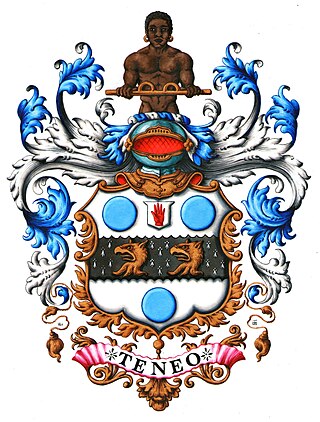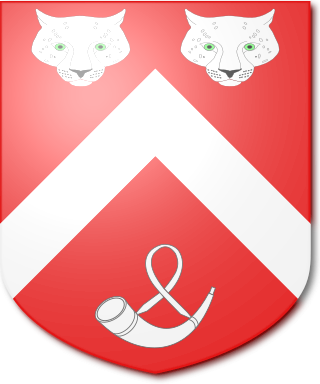Notes
- ↑ Cokayne, George Edward (1900). Complete Baronetage. Vol. I. Exeter: W. Pollard & Co., Ltd. pp. 235–236.
The Leigh Baronetcy, of Tyrone, was created in the Baronetage of Ireland in February 1622 for Sir Daniel Leigh. The title became extinct on the death of his son Sir Arthur Leigh, 2nd Baronet in 1638.

Earl of Gosford is a title in the Peerage of Ireland. It was created in 1806 for Arthur Acheson, 2nd Viscount Gosford.

There have been seventeen baronetcies for persons with the surname Stewart, ten in the Baronetage of Nova Scotia, one in the Baronetage of Ireland and six in the Baronetage of the United Kingdom. See also Steuart baronets, Henderson-Stewart baronets, MacTaggart-Stewart baronets and Stewart-Clark baronets.
The Richardson, later Richardson-Bunbury Baronetcy, of Augher in the County of Tyrone, is a title in the Baronetage of Ireland. It was created on 30 August 1787 for William Richardson. The family is originally of Scottish descent. The second baronet assumed in 1822 his grandmother's surname of Bunbury.
There have been three baronetcies created for persons with the surname O'Neill, two in the Baronetage of Ireland and one in the Baronetage of the United Kingdom.
There have been four baronetcies created for persons with the surname FitzGerald, one in the Baronetage of Ireland and three in the Baronetage of the United Kingdom.

There have been seven baronetcies created for persons with the surname Russell, three in the Baronetage of England and four in the Baronetage of the United Kingdom.
There have been seven baronetcies created for persons with the surname Wood, one in the Baronetage of England, one in the Baronetage of Nova Scotia, one in the Baronetage of Great Britain and four in the Baronetage of the United Kingdom.

The Staples Baronetcy, of Lissan in the County of Tyrone and Faughanvale in the County of Londonderry, was a title in the Baronetage of Ireland. It was created on 18 July 1628 for Thomas Staples, who later served as High Sheriff of County Tyrone.
There have been two baronetcies created for persons with the surname Piers, one in the Baronetage of Nova Scotia and one in the Baronetage of Ireland. One creation is extant as of 2008 while the other is dormant.
There have been three baronetcies created for persons with the surname Dryden, one in the Baronetage of England and two in the Baronetage of Great Britain. Two of the creations are extant and are joined under a single holder since 1874.
There have been three baronetcies created for persons with the surname Foulis, one in the Baronetage of England and two in the Baronetage of Nova Scotia.
The Nicolson baronets refer to one of four baronetcies created for persons with the surname Nicolson, all in the Baronetage of Nova Scotia. Two of the creations remain extant as of 2008.

There have been three baronetcies created for members of the Sedley family of Kent, all in the Baronetage of England. All three creations are extinct.
Sir Henry Beaumont, 2nd Baronet was an English politician.

There have been four baronetcies created for members of the Slingsby family who settled at Scriven Hall, Scriven, Knaresborough, Yorkshire in the 14th century.
The Keyt Baronetcy, of Ebrington in the County of Gloucester, was a title in the Baronetage of England. It was created on 22 December 1660 by King Charles II for John Keyt, who had raised a troop of horse to fight in the Royalist cause. Although the son of the 2nd Baronet had actually died a few days before his father, the baronetcy was allowed by royal command to pass to his eldest child, who became the 3rd Baronet and member of parliament for Warwick. The title became extinct on the death of the fifth Baronet in 1784.
The Longueville Baronetcy, of Wolverton in the County of Buckingham, was a title in the Baronetage of Nova Scotia. It was created on 17 December 1638 for Edward Longueville. The title became either extinct or dormant on the death of the fourth Baronet in 1759.

There have been two baronetcies created for persons with the surname Leicester, both in the Baronetage of England. The fifth Baronet of the second creation was raised to the peerage as Baron de Tabley in 1826. Both the barony and the two baronetcies are now extinct.
There have been five baronetcies created for persons with the surname Tyrrell, all in the Baronetage of England. All five creations are extinct, as is the Tyrell baronetcy. The six creations all claim a descent from Walter Tirell, the reputed accidental killer of King William II.
The Crosbie Baronetcy, of Maryborough in Queen's County, was created in the Baronetage of Ireland on 24 April 1630. The family was of Gaelic and Roman Catholic origin, but this branch converted to the Church of Ireland and Anglicized their name. Sir Walter, the first baronet, was the eldest son of John Crosbie, Bishop of Ardfert and Aghadoe, and a first cousin of the leading statesman Sir Piers Crosby. His brother David founded a junior branch of the family, which gained the title of Earl of Glandore. Sir Edward, the fifth baronet, was executed for treason after the 1798 Rebellion. The title became extinct on the death of the eighth baronet in 1936.